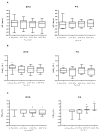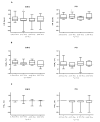Effect of bucket hydrotherapy on clinical parameters in infants with bronchopulmonary dysplasia: A pilot randomized clinical trial
- PMID: 40786527
- PMCID: PMC12335331
- DOI: 10.29390/001c.142452
Effect of bucket hydrotherapy on clinical parameters in infants with bronchopulmonary dysplasia: A pilot randomized clinical trial
Abstract
Introduction: It is unknown whether bucket hydrotherapy is beneficial to premature newborns with bronchopulmonary dysplasia (BPD).
Objective: To evaluate the effects of bucket hydrotherapy on physiological and behavioural parameters and the oxygen need in preterm infants with BPD during hospitalization.
Methods: Twenty infants with BPD were randomized into a control (conventional physiotherapy - PG) or an intervention group (conventional physiotherapy plus bucket hydrotherapy - BHG). All infants underwent twelve days of intervention, and data from the first (D1), sixth (D6) and twelfth (D12) days were analyzed. Respiratory rate (RR), heart rate (HR), peripheral oxygen saturation (SpO2), inspired oxygen fraction (FiO2), pain, respiratory effort, sleep, and wakefulness status were measured before, immediately after, and at 15, 30, and 60 minutes after the intervention.
Results: In the BHG, intragroup analysis showed lower values for FiO2 on D1 (30': p = 0.03, 60': p = 0.02), HR on D6 (p = 0.004) and RR on D12 (p < 0.03), and higher values for SpO2 on D12 (p = 0.0003). Intergroup comparisons favored BHG for SpO2 (p = 0.03; effect size [ES] =0.99) and FiO2 (p < 0.02; ES > 0.47) on D1, HR changes on D6 (p < 0.04; ES > 0.9) and D12 (p = 0.009; ES = 0.61). No significant intra- or intergroup differences were found in pain, respiratory effort, sleep, or wakefulness (p > 0.05 for all).
Discussion: Given the persistent gas exchange abnormalities in BPD, bucket hydrotherapy appears to be a feasible and beneficial non-pharmacological method for reducing oxygen requirements.
Conclusion: The present pilot study demonstrates that bucket hydrotherapy is a therapeutic intervention that reduces HR, RR and oxygen requirements in premature infants with BPD without inducing changes in behavioural parameters.
Keywords: Brochopulmonary dysplasia; hydrotherapy; neonatal intensive care unit; oxygen; premature.
Conflict of interest statement
The authors declare that there are no conflicts of interest.
Figures





References
-
- Physiological effects of bucket hydrotherapy for premature newborns. Silva H. A., Silva K. C., Reco M. O. N., Costa A. S., Soares-Marangoni D. A., Merey L. S. F. 2017Rev Ter Ocup Univ São Paulo. 28(3):309–15. doi: 10.11606/issn.2238-6149.v28i3p309-315. https://doi.org/10.11606/issn.2238-6149.v28i3p309-315 - DOI - DOI
-
- Bronchopulmonary Dysplasia - definition, pathophysiology and treatment: literature review. Piscoya M. D. B. V., Annes A. L. M., Silva G. A. A., Silva R. M. 2017Inova Saúde. 6(1):93–106. doi: 10.18616/is.v4i2.2238.1-16. https://doi.org/10.18616/is.v4i2.2238.1-16 - DOI - DOI
-
- Bronchopulmonary Dysplasia. Costa P. F. B. M. 2013Pulmão RJ. 22(3):37–42.
-
- Bronchopulmonarydysplasia: executive summary of a workshop. Higgins R. D., Jobe A. H., Koso-Thomas M., Bancalari E., Viscardi R. M., Hartert T. V.., et al. 2018J Pediatr. 197:300–308. doi: 10.1016/j.jpeds.2018.01.043. https://doi.org/10.1016/j.jpeds.2018.01.043 - DOI - DOI - PMC - PubMed
-
- Bronchopulmonary dysplasia. Jobe A. H., Bancalari E. 2001Am J Respir Crit Care Med. 163:1723–9. doi: 10.1164/ajrccm.163.7.2011060. https://doi.org/10.1164/ajrccm.163.7.2011060 - DOI - DOI - PubMed
LinkOut - more resources
Full Text Sources
